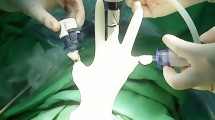Abstract
Background
Adnexal surgery is believed to be more complex in patients with prior hysterectomy; however, there is little data regarding surgical outcomes. Understanding of individualized risks improves counseling, informed consent, and preoperative planning.
Methods
We performed a retrospective cohort study with a control group; we evaluated 744 patients undergoing laparoscopic adnexal surgery at an academic tertiary care center from 2011 to 2015. Comparisons were made using Chi square, Fisher’s exact, or Wilcoxon-rank sum tests. We used log-binomial regression to calculate risk ratio and 95% confidence interval.
Results
Patients with prior hysterectomy were more likely to have intraoperative or postoperative complications at the time of laparoscopic adnexal surgery when compared to patients without prior hysterectomy [17.7% vs. 10.2%, p = 0.02, risk ratio (RR) 1.7, 95% confidence interval (CI) 1.1–2.7]. Patients with prior hysterectomy were four times more likely to have intraoperative complications (3.2% vs. 0.8%, p = 0.047, RR 4.0, 95% CI 1.1–14.7), and five times more likely to have conversion to laparotomy (5.6% vs. 1.1%, p = 0.004, RR 5.0, 95% CI 1.8–14.0). Patients with prior hysterectomy were more likely to need additional procedures, including lysis of adhesions (69.4% vs. 26.0%, p < 0.001), ureterolysis (15.3% vs. 4.8%, p < 0.001), and cystoscopy (28.2% vs. 8.1%, p < 0.001). They had longer operative time [101.5 min (IQR 59.5–135.0) vs. 78.0 min (IQR 53.0–109.0, p < 0.001)], and were less likely to have outpatient surgery (56.5% vs. 84.8%, p < 0.01). Postoperative complications were also more common (15.3% vs. 9.4%, p = 0.046).
Conclusions
Patients with prior hysterectomy were 70% more likely to have a complication at the time of laparoscopic adnexal surgery than patients without hysterectomy. Increased risk of complications in subsequent adnexal surgery may influence the informed consent process or decisions regarding ovarian conservation. Awareness of potential need for additional surgical procedures may guide availability of equipment, choice of operating site, or referral to an advanced pelvic surgeon.

Similar content being viewed by others
References
Baloglu A, Bezircioglu I, Cetinkaya B, Karci L, Bicer M (2010) Development of secondary ovarian lesions after hysterectomy without oophorectomy versus unilateral oophorectomy for benign conditions: a retrospective analysis of patients during a nine-year period of observation. Clin Exp Obstet Gynecol 37:299–302
Casiano ER, Trabuco EC, Bharucha AE, Weaver AL, Schleck CD, Melton LJ 3rd, Gebhart JB (2013) Risk of oophorectomy after hysterectomy. Obstet Gynecol 121:1069–1074
Dekel A, Efrat Z, Orvieto R, Levy T, Dicker D, Gal R, Ben-Rafael Z (1996) The residual ovary syndrome: a 20-year experience. Eur J Obstet Gynecol Reprod Biol 68:159–164
Plockinger B, Kolbl H (1994) Development of ovarian pathology after hysterectomy without oophorectomy. J Am Coll Surg 178:581–585
Larson CA (2011) Evidence-based medicine: an analysis of prophylactic bilateral oophorectomy at time of hysterectomy for benign conditions. Curr Oncol 18:13–15
Orozco LJ, Tristan M, Vreugdenhil MM, Salazar A (2014) Hysterectomy versus hysterectomy plus oophorectomy for premenopausal women. Cochrane Database Syst Rev 3:CD005638
Parker WH, Broder MS, Chang E, Feskanich D, Farquhar C, Liu Z, Shoupe D, Berek JS, Hankinson S, Manson JE (2009) Ovarian conservation at the time of hysterectomy and long-term health outcomes in the nurses’ health study. Obstet Gynecol 113:1027–1037
Parker WH, Broder MS, Liu Z, Shoupe D, Farquhar C, Berek JS (2005) Ovarian conservation at the time of hysterectomy for benign disease. Obstet Gynecol 106:219–226
Asante A, Whiteman MK, Kulkarni A, Cox S, Marchbanks PA, Jamieson DJ (2010) Elective oophorectomy in the United States: trends and in-hospital complications, 1998–2006. Obstet Gynecol 116:1088–1095
Mytton J, Evison F, Chilton PJ, Lilford RJ (2017) Removal of all ovarian tissue versus conserving ovarian tissue at time of hysterectomy in premenopausal patients with benign disease: study using routine data and data linkage. BMJ 356:j372
Wilson LF, Pandeya N, Byles J, Mishra GD (2018) Hysterectomy status and all-cause mortality in a 21-year Australian population-based cohort study. Am J Obstet Gynecol 220:83-e1
Karp NE, Fenner DE, Burgunder-Zdravkovski L, Morgan DM (2015) Removal of normal ovaries in women under age 51 at the time of hysterectomy. Am J Obstet Gynecol 213(716):e711–e716
Al-Sunaidi M, Tulandi T (2006) Adhesion-related bowel obstruction after hysterectomy for benign conditions. Obstet Gynecol 108:1162–1166
Brill AI, Nezhat F, Nezhat CH, Nezhat C (1995) The incidence of adhesions after prior laparotomy: a laparoscopic appraisal. Obstet Gynecol 85:269–272
Sokol AI, Chuang K, Milad MP (2003) Risk factors for conversion to laparotomy during gynecologic laparoscopy. J Am Assoc Gynecol Laparosc 10:469–473
Author information
Authors and Affiliations
Corresponding author
Ethics declarations
Disclosures
Roa A. Alammari, Elisa M. Jorgensen, Anna M. Modest, Jennifer Chu, Louise P. King, Christopher S. Awtrey have no conflicts of interest or financial ties to disclose.
Additional information
Publisher's Note
Springer Nature remains neutral with regard to jurisdictional claims in published maps and institutional affiliations.
Rights and permissions
About this article
Cite this article
Alammari, R.A., Jorgensen, E.M., Modest, A.M. et al. Impact of prior hysterectomy on surgical outcomes for laparoscopic adnexal surgery. Surg Endosc 34, 2980–2986 (2020). https://doi.org/10.1007/s00464-019-07083-4
Received:
Accepted:
Published:
Issue Date:
DOI: https://doi.org/10.1007/s00464-019-07083-4




